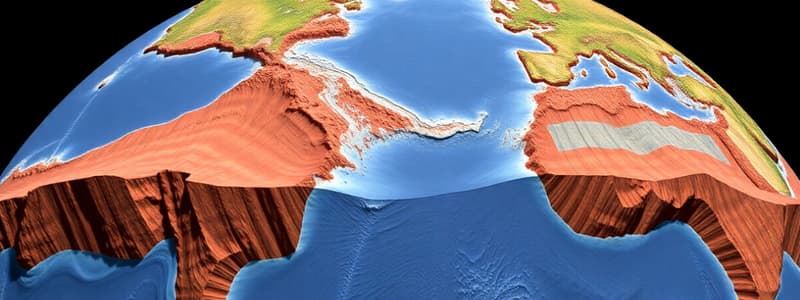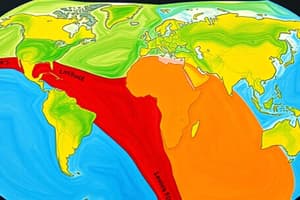Podcast
Questions and Answers
The formation of the Mariana Trench is primarily associated with which type of plate boundary?
The formation of the Mariana Trench is primarily associated with which type of plate boundary?
- Transform, due to plates sliding past each other and fracturing the crust.
- Convergent, due to one plate subducting beneath another, creating a deep oceanic trench. (correct)
- Convergent, due to plates colliding and folding upwards to create deep valleys.
- Divergent, due to plates moving apart and creating a deep valley.
The East African Rift Valley is characterized by lowland valleys and steep faults. This geological feature is a direct result of which type of plate boundary?
The East African Rift Valley is characterized by lowland valleys and steep faults. This geological feature is a direct result of which type of plate boundary?
- Convergent boundary, where compressional forces create valleys.
- Divergent boundary, where tensional forces pull plates apart, causing the crust to fracture and drop. (correct)
- Subduction zone, where the sinking plate creates depressions in the overriding plate.
- Transform boundary, where horizontal sliding creates linear valleys.
Earthquakes along the San Andreas Fault are primarily caused by which type of plate movement?
Earthquakes along the San Andreas Fault are primarily caused by which type of plate movement?
- Plates colliding head-on, causing intense pressure and sudden releases of energy.
- One plate subducting beneath another, leading to deep-seated seismic activity.
- Plates moving apart, creating gaps in the crust that suddenly collapse.
- Plates sliding past each other horizontally, resulting in friction and periodic releases of built-up stress. (correct)
If two tectonic plates are described as moving 'towards each other', which type of plate boundary is being described?
If two tectonic plates are described as moving 'towards each other', which type of plate boundary is being described?
Both convergent and divergent plate boundaries can result in the formation of mountains. However, the process of mountain building differs. Which of the following statements best describes a key difference in mountain formation between these two boundary types?
Both convergent and divergent plate boundaries can result in the formation of mountains. However, the process of mountain building differs. Which of the following statements best describes a key difference in mountain formation between these two boundary types?
When a continental plate and an oceanic plate converge, which of the following geological processes is most likely to occur?
When a continental plate and an oceanic plate converge, which of the following geological processes is most likely to occur?
The movement of tectonic plates is primarily driven by which of the following mechanisms within the Earth?
The movement of tectonic plates is primarily driven by which of the following mechanisms within the Earth?
At a convergent boundary where two continental plates collide, which of the following is the most likely outcome?
At a convergent boundary where two continental plates collide, which of the following is the most likely outcome?
Compared to continental plates, oceanic plates are generally:
Compared to continental plates, oceanic plates are generally:
Which geological feature is commonly associated with convergent boundaries where subduction occurs?
Which geological feature is commonly associated with convergent boundaries where subduction occurs?
Flashcards
Tectonic Plates
Tectonic Plates
Large sections of the Earth's lithosphere that move on the liquid mantle.
Continental Plates
Continental Plates
Lighter, less dense plates composed of granite rocks.
Oceanic Plates
Oceanic Plates
Denser, heavier plates composed of basaltic rocks.
Convergent Boundary
Convergent Boundary
Signup and view all the flashcards
Convergent Boundary Formations
Convergent Boundary Formations
Signup and view all the flashcards
Convergent Plate Boundary
Convergent Plate Boundary
Signup and view all the flashcards
Divergent Plate Boundary
Divergent Plate Boundary
Signup and view all the flashcards
Oceanic Trench
Oceanic Trench
Signup and view all the flashcards
Mid-Atlantic Ridge
Mid-Atlantic Ridge
Signup and view all the flashcards
Transform Plate Boundary
Transform Plate Boundary
Signup and view all the flashcards
Study Notes
- Tectonic plates are large sections of Earth's lithosphere, or crust, that interact in various ways.
Tectonic Plates
- Tectonic plates are large slabs of the Earth's crust that move freely on currents in the liquid mantel beneath the lithosphere
- The mantle is the portion of the Earth that is molten rock.
- Liquid magma heats up as it moves closer to the Earth's core, becomes less dense, and rises.
- Magma cools at the surface and sinks again, creating convection currents that cause tectonic plate movement.
- Continental and oceanic are the two main types of tectonic plates, differentiated by composition, not location.
- Continental plates are lighter and less dense, composed of granite rocks made of quartz and feldspar
- Oceanic plates are denser and heavier, composed of basaltic rocks.
Plate Boundaries
- Plate boundaries are the ways that tectonic plates interact with each other.
- Convergent, divergent, and transform are the three main types of boundaries.
Convergent Boundaries
- A convergent plate boundary is where two plates collide
- Convergent boundaries can occur between oceanic and continental plates, or between two of the same plates.
- When a continental and oceanic plate collide, the denser oceanic plate subducts (sinks) under the continental plate.
- When two oceanic plates collide at a convergent boundary, one will sink under the other.
- When two continental plates collide, they are both pushed upward to form large mountain ranges.
- The collision of the India Plate with the Eurasian Plate, forming the Himalayan mountains, is an example of a convergent boundary.
Landforms of Convergent Boundaries
- Mountains, volcanoes, and subduction zones with large trenches can form from convergent boundaries.
- The collision of two plates can push crusts together, forming mountain ranges like the Himalayas.
- Convergent boundaries between oceanic and continental plates have a subduction zone.
- Magma can escape through the lithosphere at a subduction zone, forming volcanoes and mountains.
- Volcanic mountain ranges like the Cascades or the Andes are formed this way.
- Subduction zones can also form large trenches like the Mariana Trench, and volcanic islands like the Aleutian Islands.
Divergent Plate Boundaries
- Divergent plate boundaries occur when two plates separate from each other.
- The Mid Atlantic Ridge is the largest underwater mountain range, formed by a divergent plate boundary.
Landforms of Divergent Boundaries
- Rift valleys, oceanic trenches, and underwater mountain ranges are created from divergent plate boundaries.
- At a divergent boundary, two plates move apart and new magma rises, creating new crust.
- The Mid Atlantic Ridge is a divergent plate boundary spanning the Atlantic Ocean.
- Magma released into the ocean at the Mid Atlantic Ridge forms a large mountain chain.
- The East Africa Rift Valley is formed where the Somalian plate moves away from the Nubian plate.
- Extension of the crust in the East Africa Rift Valley region forms lowland valleys with steep faults.
Transform Plate Boundaries
- Transform boundaries are areas where two plates slide past each other.
- The San Andreas Fault in California is a well-known transform boundary.
Landforms of Transform Boundaries
- Transform boundaries create fault lines, where plates slide past each other horizontally and cause rock to fracture.
- Pressure builds up behind plates at fault lines, rock is smashed, and energy is released as earthquakes.
- Normal, reverse, strike-slip and oblique are types of fault lines created by transform boundaries.
- In a normal fault, the higher rock moves down.
- In a reverse fault, the lower rock moves up.
- In a strike-slip fault, the plates move horizontally past each other.
- Oblique faults have movement that cannot be classified completely as any of the other faults, but is in the strike-slip plane along with normal or reverse movement.
- The San Andreas Fault is a strike-slip fault between the Pacific and North American plates.
- The movement of the plates sliding past each other at the San Andreas Fault has caused many earthquakes in California.
Convergent vs. Divergent Boundaries
- Convergent boundaries have plates that move towards each other, while divergent boundaries have plates that move away from each other.
- Mountains and volcanoes can be created by both convergent and divergent boundaries, although the geology of how these features form is different.
Studying That Suits You
Use AI to generate personalized quizzes and flashcards to suit your learning preferences.




